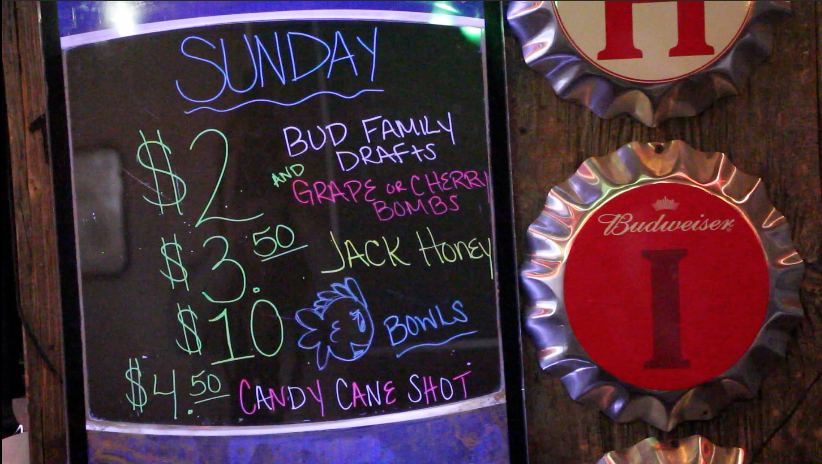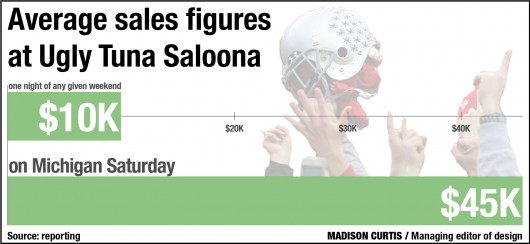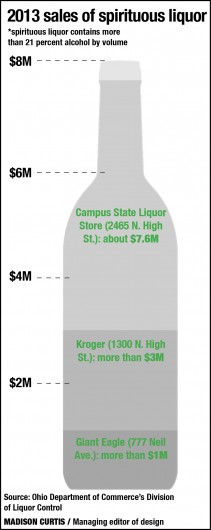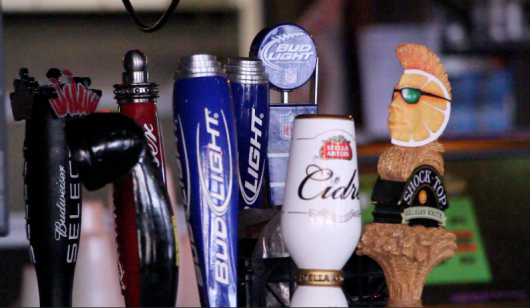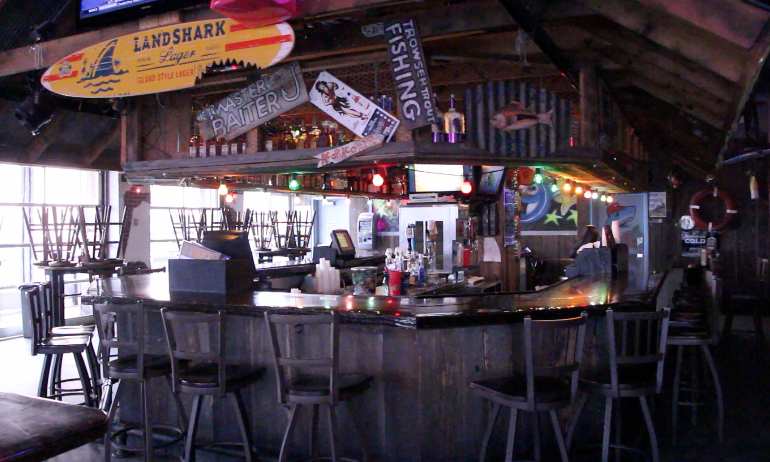Books, bank and booze.
Three things many students consider quintessential to the college experience — and all items that can be found on High Street. Yet of all three college “necessities,” it appears the latter is the most abundant.
Sprinkled across a 1.2-mile stretch of the University District’s portion of High Street lie two bookstores, four banks and more than 20 bars.
And that’s not including bars in the University District located about six blocks or less off High Street. Tack those bars onto the count, and the total number of off-campus bars jumps to roughly 30.
And there’s more. There are also restaurants on High Street that serve alcohol, as well as off-campus liquor stores.
Studies have found that college campuses are often surrounded by bars and restaurants where alcohol is sold, said Aaron White, the National Institute on Alcohol Abuse and Alcoholism program director for Underage and College Drinking Prevention Research, so coming in and out of the campus area often involves going past dozens of opportunities to drink.
The point is that on college campuses, there’s a demand for alcohol, and with demand comes profit.
Kenny Perry is the general manager of Ugly Tuna Saloona, an off-campus bar in the South Campus Gateway, where he said alcohol is the primary money-maker for his business.
“Let’s be honest, it’s a place where alcohol is served, and most of our business is alcohol,” Perry said.
For the most part, Perry said customers aren’t eating food when they come to his bar. Even though his business offers a full menu, he said his customers are primarily there for the alcohol.
Perry estimates a total of 600 people come into his bar on any given Friday or Saturday night, his busiest nights of the week. Of those 600 people, he said about 85 percent are college students or people who fall into the 21- to 24-year-old age range.
Those 600 people aren’t in the bar all at once, though.
“It’s a cycle. People come in, people kind of go. It’s just a constant stream of people in and out,” he said.
And with all those customers, Perry said it’s normal for the bar to make $10,000 on one weekend night. That means on just weekends alone, Ugly Tuna — and maybe more bars — makes close to $1 million a year.
On a football Saturday, and particularly on a home football Saturday, Perry said the bar can make even more money. For example, on perhaps the biggest day for tailgating OSU football this year — Michigan Saturday — Perry said the bar made about $45,000.
Stores selling liquor around campus can make out well, too.
In 2013, the Kroger at 1350 N. High St. sold more than $3 million worth of spirituous liquor. A Giant Eagle at 777 Neil Ave. sold more than $1 million worth. And Campus State Liquor Store, located at 2465 N. High St., sold about $7.6 million worth of spirituous liquor, according to figures provided by the Ohio Department of Commerce’s Division of Liquor Control.
Those are some of the closest stores to campus that sell spirituous liquor.
A spirituous liquor contains more than 21 percent alcohol by volume, so that includes beverages like Jack Daniel’s Old No. 7 (40 percent ABV), Captain Morgan Original Spiced Rum (35 percent ABV) and Smirnoff No. 21 Vodka (40 percent ABV).
Figures aren’t available for beer, wine and low-proof liquor sales.
Some stores that sell alcohol only about a block off of campus — like Tobacco International and PJ’s — don’t sell high-proof liquor, but do sell low-proof beverages like Captain Morgan’s Parrot Bay rum (21 percent ABV). There isn’t a boundary keeping them from selling spirituous liquor, spokesman Matt Mullins of the Division of Liquor Control said, and stores could apply for a permit to sell high-proof alcohol.
The Division of Liquor Control, though, determines when and where to open a store that can sell high-proof liquor, Mullins said. There are limits on how many can be operating in a particular area, but he said the number of liquor stores in operation is well below what would legally be allowed.
So how exactly are businesses making this kind of money? After all, college students are known for being broke.
Part of the profit comes down to bar specials, and those are particularly important at bars located near college campuses.
“You know, college students are always on a budget so they need to go somewhere where their dollar stretches,” Perry said.
As soon as Ugly Tuna opens at 4 p.m., the bar offers happy hour, which Perry said is $2 off all drafts, $2 Long Island iced teas and $2 well drinks — mixed drinks made with cheap liquor — among others. Still, Perry said the night usually starts out slowly.
After 8 p.m., Ugly Tuna offers what it calls Ugly Hour, which Perry describes as a “ramped up version of happy hour.” That’s when the bar offers $1 drinks, and it’s about that time that the bar starts to get busy, Perry said.
“Come about 10, it’s just party central at that point in time. We got a DJ going on, it’s packed at this point in time and everybody’s here to have a good time. So you know, it’s just a party at that point in time,” Perry said.
Other campus bars offer specials as well. Walking down High Street on a Monday or Thursday, you’ll likely see at least a few people wielding schooners — 32-ounce glass goblets that can be refilled with beer or mixed drinks for as little as $2 at Chumley’s. Heading down Frambes Avenue on a Sunday or a Monday, you’ll probably cross paths with people holding plastic beer mugs in every shade of the rainbow emblazoned with the Out-R-Inn bar logo. Those can be refilled for as low as $1.75.
And those specials are just a few examples.
The Lantern made multiple attempts to reach other bars in the area, including Little Bar, Chumley’s, Out-R-Inn and Ethyl & Tank, none of which returned a request for comment.
During Ugly Hour, Perry estimated his customers are having one drink every half hour. Perry said he doesn’t think customers are drinking more alcohol during these specials, rather, just drinking different alcoholic beverages they wouldn’t normally consume.
For example, Perry said when he’s offering a Jack Daniel’s special, a customer might drink more Jack Daniel’s that night than their more typical drink of choice.
“For the college student, prices really affect what they want to drink,” Perry said.
A graduate student in business administration at OSU, who also attended OSU for his undergraduate degree, said the places he drank shifted over his time at the university.
“It starts with the house parties, and then when you get older, it kind of migrates to the bars,” he said, adding that people are “trying to find a place where it’s most age appropriate.”
But that doesn’t necessarily mean that students binge drink — or drink to get drunk — more or less often at house parties or bars.
With all that alcohol, Perry said his customers will sometimes drink too much — so much so that he’ll have to cut them off. He said it often happens in college-atmosphere bars because many customers bar hop and go to multiple bars in one night.
Perry said he has to cut someone off about once a night.
“When you are dealing with 600-700 guests on a Friday night, it happens. It’s not like every other person … (but) it happens,” Perry said.
White, at the NIAAA, said students tend to take advantage of cheap drink specials. There’s a known relationship, he said, between price and levels of drinking — when price goes up, consumption goes down, and so does harm.
A study published in Substance Abuse Treatment, Prevention, and Policy in April found that certain groups of students were likely to change their drinking behavior during happy hours. Those groups included women, students under age 21, Greek Life members, more affluent and unemployed students, those who aren’t student-athletes and those who live on campus.
It found that while that change was tied to other negative and illegal behavior, it wasn’t tied to an increased likelihood of an alcohol-related arrest. Those other behaviors included driving under the influence, unprotected sexual intercourse with a stranger while under the influence and fighting while intoxicated.
The study concluded that drink specials should be regulated to curb those negative effects.
College drinking isn’t rare. About 80 percent of students drink, according to the NIAAA. And half of those are binge drinking, which is having about four drinks in two hours for women, or five drinks in that time for men, according to the NIAAA.
White said research suggests there are two things that can be done — bars could not offer cheap drink specials and they could check IDs.
Although he can’t truly know when someone is over the limit, Perry said his employees pay attention to customers’ behaviors to figure out when they’ve reached their limit. For Perry, he said that’s part of his responsibility as a bar manager.
“It is definitely a responsibility. We want to make sure, not how much you are drinking, but the behavior associated with it, making sure no one gets over-served. You have to take that seriously, you have to be aware that that’s a possibility when you serve alcohol and you want to serve them responsibly. I want everyone to have a drink, but I also want them to drink responsibly,” he said.
The NIAAA’s website said, “The problem with college drinking is not necessarily the drinking itself, but the negative consequences that result from excessive drinking.” Every year:
- 1,825 students between 18 and 24 years old die from alcohol-related injuries.
- More than 690,000 are physically assaulted by someone else who had been drinking.
There are also academic repercussions — every year, about 25 percent of students report receiving lower grades or other consequences because of drinking. And there are personal health concerns — 150,000 students have a health problem related to alcohol.
Bars have their liquor permits to worry about, too.
In the campus area, there have been at least seven liquor permit violations between this year and last, ranging from tax problems to sale and/or furnishing to a person under 21. Ugly Tuna has an active violation for the latter. Other recent violations include Formaggio’s for “beer in original container capacity more than 5 1/6 gallons,” though it was dismissed, and at least one other bar has an active violation for a tax problem and a “bad check pending — beer and wine,” among others.
When it comes to college students trying to use fake IDs, Perry said “it happens quite a bit.” On a typical Friday or Saturday night, he gets about four or five people trying to use them.
“It happens a lot … and we don’t tolerate it,” he said.
Perry said they do everything within their power to prevent underaged persons from getting served — even requiring out-of-state patrons to provide two forms of identification — but still, sometimes it’s impossible to tell the difference between the fake and the real thing, he said.
Some Ohio State students said they’ve used fakes in the past.
A second-year OSU student in speech and hearing sciences, who wished to remain anonymous because she isn’t 21, said while she doesn’t have a fake ID, a lot of her friends do.
“I wouldn’t feel comfortable using one to buy alcohol, but just to like get into a bar or something, but I just haven’t been able to cross that line of searching out how to get a fake ID and then making it be worth it,” she said.
“I’m just the type of person where I’m like, ‘I’d rather not,’” she added. “I like rules, I don’t want to go there and then have something happen where they take it away or whatever and go through the stress of that.”
But occasionally she and her friends “pass-back,” which is when one person gets admitted to a bar and passes the ID back for others to try to use. She said she’s liked going to the 21-and-up bars from those experiences, as opposed to the 18-and-up ones she can get into without a fake.
“It’s such a more chill atmosphere because everyone’s normal and everyone’s not creepy,” she said.
The graduate student in business administration said he only used a fake ID once — “it was a horrible fake ID and it was to get into a bar and I can’t believe it worked.” He said not having one for a while likely helped him to stay out of trouble.
And from his experiences with the college world of alcohol, Perry said the majority of students act responsibly while at the bars. In his eyes, it’s not the bars where many alcohol-usage problems arise — it’s at home.
“I would say that as far as my experience here on campus, it’s fun. It’s fun dealing with college students,” Perry said. “I think responsible alcohol consumption takes place at businesses. I think the irresponsible ones are at home.”
This article is the third in a series about alcohol use on Ohio State’s campus. The series was made possible by the generosity of Ohio State and The Lantern alumna Patty Miller.
